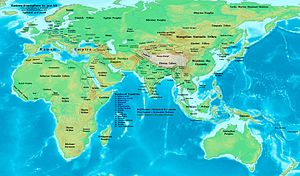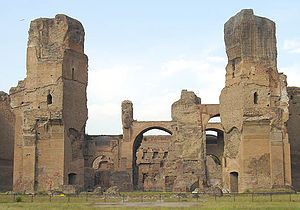
3rd century
Did you know...
This Wikipedia selection is available offline from SOS Children for distribution in the developing world. SOS mothers each look after a a family of sponsored children.
| Millennium: | 1st millennium |
|---|---|
| Centuries: |
|
| Decades: | 200s 210s 220s 230s 240s 250s 260s 270s 280s 290s |
| Categories: | Births – Deaths Establishments – Disestablishments |
| Millennium: | 1st millennium |
|---|---|
| Centuries: |
|
| Decades: | 200s 210s 220s 230s 240s 250s 260s 270s 280s 290s |
| Categories: | Births – Deaths Establishments – Disestablishments |
The 3rd century was the period from 201 to 300 A.D.
In this century, the Roman Empire saw a crisis, marking the beginning of Late Antiquity. In Persia, the Parthian Empire was succeeded by the Sassanid Empire.
In India, the Kushan Empire was replaced by the Gupta Empire. China was in the Three Kingdoms period. The Xiongnu formed the Tiefu state under Liu Qubei. Korea was ruled by the Three Kingdoms of Korea. Japan entered the Kofun period.
At about this time in Sub-Saharan Africa, the Bantu expansion reached Southern Africa.
In Pre-Columbian America, the Adena culture of the Ohio River valley declined in favour of the Hopewell culture. The Maya civilization entered its Classic Era.
Roman Empire
After the death of Commodus in the previous century the Roman Empire was plunged into a civil war. When the dust settled, Septimius Severus emerged as emperor, establishing the Severan dynasty. Unlike previous emperors, he openly used the army to back his authority, and paid them well to do so. The regime he created is known as the Military Monarchy as a result. The system fell apart in the 230s, giving way to a fifty-year period known as the Military Anarchy or the Crisis of the Third Century, where no fewer than twenty emperors held the reins of power, most for only a few months. The majority of these men were assassinated, or killed in battle, and the empire almost collapsed under the weight of the political upheaval, as well as the growing Persian threat in the east. Under its new Sassanid rulers, Persia had grown into a rival superpower, and the Romans would have to make drastic reforms in order to better prepare their state for a confrontation. These reforms were finally realized late in the century under the reign of Diocletian, one of them being to divide the empire into an eastern and western half, and have a separate ruler for each.
Events
- Early 3rd century – Burial in catacombs becomes common.
- 208: the Chinese naval Battle of Red Cliffs occurs.
- 211 – 217: Caracalla, Roman Emperor.
- 212: Constitutio Antoniniana grants citizenship to all free Roman men.
- 212 – 216: Baths of Caracalla.
- 220: The Han Dynasty comes to an end with establishment of the Three Kingdoms in ancient China.
- 222 – 235: Alexander Severus, Roman Emperor.
- 230 – 232: Sassanid dynasty of Persia launches a war to reconquer lost lands in the Roman east.
- 235 – 284: Crisis of the Third Century shakes Roman Empire.
- 250 – 538: Kofun era, the first part of the Kofun period in Japan.
- 258: Valerian's Massacre of Christians.
- 260: Roman Emperor Valerian I is taken captive by Shapur I of Persia.
- 265: The Jin Dynasty is founded after the overthrow of the Cao Wei Dynasty by Sima Yan.
- 280: The Jin Dynasty reunites China under one empire after the conquest of Eastern Wu.
- 284 – 305: Diocletian, Roman Emperor.
- Sarnath becomes a centre of Buddhist arts in India.
- Diffusion of maize as a food crop from Mexico into North America begins.
- The Kingdom of Funan reaches its zenith under the rule of Fan Shih-man.
- The Goths move from Gothiscandza to Ukraine, giving birth to the Chernyakhov culture.
- Menorahs and Ark of the Covenant, wall painting in a Jewish catacomb, Villa Torlonia (Rome), is made.
- The Coptic period begins.
- Siddhartha in the Palace, detail of a relief from Nagarjunakonda, Andhra Pradesh, India, made. Later Andhra period. It is now kept at National Museum, New Delhi, (approximate date).
- Jonah Swallowed and Jonah Cast Up, two statuettes of a group from the eastern Mediterranean, probably Asia Minor, made. Now kept at The Cleveland Museum of Art.
- Late 3rd century-early 4th century – Good Shepherd, Orants and Story of Jonah, painted ceiling of the Catacombs of Marcellinus and Peter in Rome, made.
Significant people
- Clement of Alexandria, Christian head of Catechetical School of Alexandria
- Cornelius, bishop of Rome
- Cyprian, bishop of Carthage
- Diocletian, Roman emperor
- Diophantus of Alexandria, wrote Arithmetica
- Hippolytus, considered first Antipope
- Liu Hui, Chinese mathematician
- Mani (prophet), founder of Manichaeism
- Origen, Christian theologian and priest
- Nagarjuna, Buddhist monk
- Pappus of Alexandria, Greek mathematician
- Plotinus, founder of Neoplatonism
- Tertullian, Christian theologian, Father of Christian Latin literature
- Wang Bi, Taoist
- M. Sattonius Iucundus, restorer of the Thermae in Heerlen
- Zhuge Liang, known as the greatest strategist during the period of the Three Kingdoms
- Liu Bei, founding emperor of the Kingdom of Shu
- Cao Cao, founding emperor of the Kingdom of Wei
- Sun Quan founding emperor of the Kingdom of Wu
Inventions, discoveries, introductions
- A primitive form of eyeglasses were developed for a nearsighted princess in Syria.
- The South Pointing Chariot invented by Ma Jun, a wheeled mechanical device that acts as a directional compass
- An early type of hot air balloon used for military signalling, known as the Kongming lantern was said to be invented by Zhuge Liang.
- The repeating crossbow or semi-automatic crossbow is an improved version of a model that first appeared during the Warring States Period (though there is debate whether the original Warring States Period bow was semi-automatic, or rather shot multiple bolts at once). Nevertheless, Zhuge's version could shoot farther and faster.
- Some sources report that Zhuge Liang invented a primitive land mine type device.
- A mysterious but efficient automatic transportation device (initially used for grain) referred to as the " wooden ox and flowing horse" (木牛流馬) also invented by Zhuge, which is sometimes identified with the wheelbarrow.
Decades and years
|
|||||||||||||||||||||||||||||||||||||||||||||||||||||||||||||||||||||||||||||||||||||||||||||||||||||||||||||||||||||||||||||||||||||||||
|
|||||||||||||||||||||||||||||||||||||||||||||||||||||||||||||||||||||||||||||||||||||||||||||||||||||||||||||||||||






